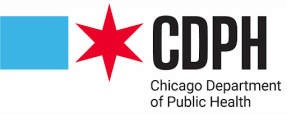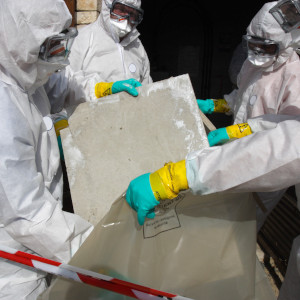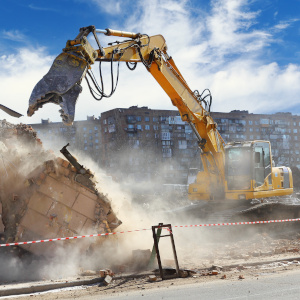Site Clean-Up & Hazardous Material Disposal
Looking for household recycling?
Click the button below:

The Chicago Department of Public Health’s (CDPH) environmental team protects residents from exposure to hazardous materials and toxic pollutants by:
- Collecting hazardous materials at the Household Chemical and Computer Recycling Facility. The City of Chicago has instructions or drop-off locations for household waste like computers, chemicals, or compact fluorescent light bulbs.
- Creating guidelines and requiring permits for demolition and renovation projects for debris recycling and potential hazards.
- Working with the appropriate state and federal agencies to identify contaminated sites and create plans for cleanup.
- Determining what clean up may be necessary if there is a hazardous waste incident in the city, such as an accidental spill.
Contractor Demolition, Renovation, and Construction Disposal
Non-household construction workers have their own permits and practices to follow when it comes to waste disposal. Information and links to specific permits can be found below.
Asbestos
Many buildings in Chicago, especially those built before 1978, were constructed or decorated with materials that may contain lead-based paint or asbestos. It is imperative that such materials be properly handled during demolition, renovation, alteration, repair, cleaning and maintenance activities to protect those who might come into contact with the debris, from the workers to the general public.
Therefore, contractors doing such work must comply with certain requirements set forth in the Chicago Municipal Code, including Sections 11-4-2150 - 11-4-2190, and must provide certain notifications to CDPH.
All notices must be submitted online through the City of Chicago Permit Portal at https://ipi.cityofchicago.org/Profile. A Notice of Asbestos Abatement form must be submitted to CDPH through the online portal at least ten working days prior to the start of any work that will disturb any amount of asbestos in any building, except single family homes. For emergency work, the Notice must be submitted no later than the following work day. See Section 11-4-2170(e)(3) of the Chicago Municipal Code.

Demolition
All demolition permit applicants must submit a Demolition Notice of Intent Form to CDPH through the City of Chicago online Permit Portal. The form has been updated recently to include requirements for more detailed reporting to ensure the protection of public health and the environment, such as planned measures to control dust and abate asbestos and other hazardous materials, as applicable.
For non-emergencies, the form must be submitted ten working days prior to the start of any non-emergency demolition of any building. For emergency demolitions, the notice must be submitted no later than one day before the start date of the emergency demolition. See Section 11-4-2170(a) of the Chicago Municipal Code.
Contractors with questions may email CDPHPermits@cityofchicago.org.
For more information, please see the info and documents below:
- Asbestos, demolition or renovation, sandblasting, and grinding standards
- Demolitions, Renovations & Asbestos Abatement - FAQ for Contractors
- Asbestos Abatement/National Emission Standards for Hazardous Air Pollutants (NESHAP) Form
- Architectural Surface Cleaning Permit Application
- Lead-Safe Renovations - Form LRRP
- Lead-Safe Renovations - A Guide to Filing Form LRRP
- Complex Demolitions

Construction and Demolition Debris Recycling
The Department of Public Health promotes the responsible separation and recycling of construction and demolition (C&D) debris to help contractors and property owners save on costly disposal fees while protecting the environment. Under the Construction and Demolition Site Waste Recycling Ordinance, contractors must:
- Keep track of the amount of C & D debris that is generated on project sites.
- Recycle at least 50% of the recyclable debris that is generated.
- Submit a Recycling Compliance Form to the Department of Public Health at the end of each project, along with an affidavit from the waste hauler or recycler.
To find out which projects must comply and how compliance is enforced, see the text of the ordinance. For more information about documenting your compliance with the C&D recycling requirements, read the C&D Recycling Rules and Regulations.
What is C&D Debris?
C&D debris is non-hazardous, non-contaminated solid waste resulting from construction, remodeling, repair or demolition projects on pavement, buildings and other structures. It may include:
- Bricks, concrete, rock and other masonry materials
- Wood, including non-hazardous painted, treated, and coated wood
- Scrap metal
- Plaster & Gypsum drywall
- Plumbing fixtures and piping
- Non-asbestos insulation
- Roofing shingles and other roof coverings
- Reclaimed asphalt pavement
- Glass and plastics
- Landscape waste
Benefits of C&D Recycling
- Recycling C&D debris saves money. Contractors can save money through avoided tipping (disposal) fees and by reselling or reusing C&D materials on future projects. These savings can allow a firm to be more competitive on bids for C&D projects.
- Recycling C&D debris is good for the environment. In the U.S., C&D debris accounts for 30% of all solid waste produced. Most of this waste goes to landfills. Recycling C&D debris conserves valuable landfill space and reduces consumption of resources.
- On average about 500,000 tons of C&D are recycled annually, or a recycling rate of approximately 85% of total recyclable C&D debris generated.
How to Recycle C&D Debris
The first step in C&D recycling is to plan ahead. It is important to estimate how much and what types of material will be generated at the construction or demolition site. Then you can decide how the materials should be sorted and which recycling service providers you should hire.
For more information, the City provides a Construction and Demolition Best Management Practices Guide for C&D operations. This guide includes case studies and strategies for meeting the C&D recycling requirements.
A searchable database of reuse and recycling services may be accessed at Earth 911.
Supporting Documents & Resources
- Construction & Demolition Debris Recycling Brochure
- Construction Best Management Practices
- Construction and Demolition Debris Recycling Rules and Regulations
- Construction and Demolition Recycling Compliance Form
- Construction and Demolition Recycler Affidavit
- Contractor Form - Revision of Project Declared Completion Date
Highway Authority Agreement
A highway authority agreement is recognized as an “institutional control” for sites that have been remediated in accordance with the Illinois EPA’s Tiered Approach to Corrective Action Objectives and where the Illinois EPA has determined that no further remediation is required as to the property(ies) to which the agreement is to apply. The City of Chicago has established a model highway authority agreement for those properties to which the agreement is to apply.
For additional information, please contact CDPH at 312.745.8295.




